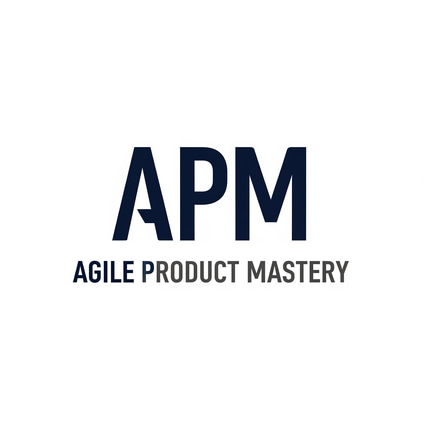Understanding Agile: A Beginner’s Guide for New Product Owners
Demystify Agile for business Product Owners new to tech. Learn core principles, benefits, and how it applies to your product development role from scratch.
AGILE PRODUCT MANAGEMENTAGILE BEGINNERS GUIDEAGILE MINDSET
Written by: Matt Gregory - Founder Agile Product Mastery
6/6/20254 min read


Introduction: From Business to Product – The New PO Challenge
Step into the world of Agile. You are not alone if you are a new Product Owner (PO) with experience in a business function such as sales, operations, finance, or marketing. These days, a lot of companies put business leaders and other top executives in the driver's seat when it comes to creating new products. But here's the rub: Agile might make you feel like you're learning a foreign language.
While you're still learning the ropes, you could be asked to "groom a backlog," ask about story points and velocity, or participate in daily stand-ups. This guide will help you understand Agile, why it's important, and lay the groundwork for a successful career as a product owner in the technology industry.
What Is Agile, Really?
Agile is not fundamentally about any one process or tool. It's a way of thinking—a strategy for developing collaborative, adaptable products that users want fast. Agile principles emerged as a reaction to the problems with more conventional, plan-heavy software development approaches.
• Individuals and interactions over processes and tools
• Working software over comprehensive documentation
• Customer collaboration over contract negotiation
• Responding to change over following a plan
These principles are encapsulated in the Agile Manifesto, which was draughted in 2001 by a collective of software professionals. The good news is that being a developer isn't required to fully appreciate Agile. As a business Product Owner, your fresh eyes and user-centric thinking are assets in an Agile team.
The Key Agile Principles for Product Owners
While Agile has 12 principles, here are the ones that matter most for you as a PO:
1. Deliver value early and often – Working in small, frequent releases helps reduce risk and gather real user feedback faster.
2. Welcome changing requirements – Priorities shift, markets change. Agile embraces that reality.
3. Business people and developers must work together – Your role as a PO is to bridge this gap.
4. Build projects around motivated individuals – Trust the team to make decisions. Your job is to set direction, not micromanage.
5. Simplicity is essential – Maximize value by doing less, not more. Focus on outcomes.
What Is Scrum (And Do I Need to Know It)?
The most well-known Agile framework is Scrum, so yes, you should be familiar with its fundamentals.
I'll give you the simplified version:
• Sprints – Time-boxed iterations (usually 2 weeks) where the team builds and delivers a slice of the product.
• Product Backlog – Your to-do list, prioritised by business value. You own this.
• Daily Stand-Ups – 15-minute team check-ins. You listen and unblock if needed.
• Sprint Planning – You collaborate with the team to decide what will be done in the sprint.
• Sprint Review – You gather feedback from stakeholders on what was built.
• Sprint Retrospective – The team reflects on how to improve for next time.
Scrum gives structure to Agile, but remember, it’s a means to an end, not the goal itself.
What Does a Product Owner Actually Do?
Think of yourself as the voice of the customer and the translator between business and tech. Your core responsibilities include:
• Defining and owning the product vision – Why are we building this? Who is it for?
• Managing the product backlog – Writing, prioritising, and refining user stories with clear acceptance criteria.
• Making trade-offs – Balancing what users want, what’s feasible, and what delivers value fastest.
• Collaborating constantly – With developers, designers, testers, stakeholders, and users.
• Measuring success – Using data and feedback to steer the product.
You don’t need to know how to code but you do need to understand how tech teams work, and how your product creates value.
The Business Value of Agile (Why It Matters to You)
Agile isn’t just a trendy tech thing. It has real business advantages:
• Faster time to market – Get usable features to customers in weeks, not months.
• Early ROI – Prioritise high-value work and deliver it sooner.
• Reduced risk – By releasing often and validating assumptions early, you avoid costly mistakes.
• Higher customer satisfaction – Frequent feedback loops mean you build what people actually want.
• Empowered teams – Agile teams are more motivated, responsive, and aligned with customer outcomes.
If your background is in business strategy or customer experience, Agile amplifies your impact by making you a direct driver of value.
Tools You Might Encounter (And How to Use Them)
Don’t worry—you’ll pick these up quickly. The key tools new POs encounter are:
• Jira or Azure DevOps – For managing sprints, tracking tasks, and visualising progress.
• Confluence or Notion – For documenting product decisions and roadmaps.
• Figma or Miro – For collaborating on design and user flows.
• Slack or Teams – For fast, async team communication.
In order to keep your team on the same page and your backlog organised and useful, you don't have to become an expert in every tool.
Common Traps for New Product Owners
Here are some classic missteps to watch for:
1. Acting like a project manager – Agile isn’t about managing timelines or assigning tasks. It’s about empowering teams and prioritising value.
2. Writing poor user stories – Stories should be small, valuable, and testable. Learn the INVEST model (Independent, Negotiable, Valuable, Estimable, Small, Testable).
3. Overprioritising everything – Not everything is P1. Be ruthless about what delivers the most value now.
4. Ignoring technical debt – Work with your team to balance delivering features with improving code quality.
5. Failing to say no – Stakeholders will push. You need to guard the backlog like it’s a strategic asset—because it is.
How to Learn Agile by Doing
The best way to learn Agile is to do it. Here are some simple tips to accelerate your growth:
• Pair with your Scrum Master – They can help you understand ceremonies, roles, and delivery rhythm.
• Attend user story workshops – Practice writing and splitting stories until it becomes second nature.
• Join sprint reviews and retrospectives – Observe how feedback and improvement are baked in.
• Ask your team lots of questions – About the tech, the users, and how they prefer to work.
• Read one Agile article or book chapter a week – Start with Scrum: The Art of Doing Twice the Work in Half the Time or Inspired by Marty Cagan.
Final Thoughts: You Belong Here
A non-technical or business perspective is valuable when stepping into Agile, so keep that in mind. The perfect combination of technical prowess, business acumen, and customer empathy is what makes agile work. With the first two, you're already well-equipped; the rest, you'll figure out as you work with and develop alongside your team.
Being a Product Owner isn't about being an expert in every field. Being inquisitive, flexible, and laser-focussed on providing value are key. Get out there, make your voice heard, and lead with conviction.
Welcome to the Agile journey. You’ve got this.
© Agile Product Mastery — Build a career that scales. Not one that burns out.
Powered by Baltimore Advisory Pty Ltd — ABN 97 678 312 475 — All rights reserved
Follow us on LinkedIn
